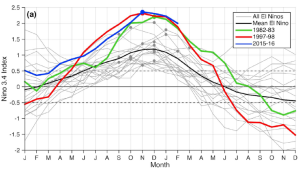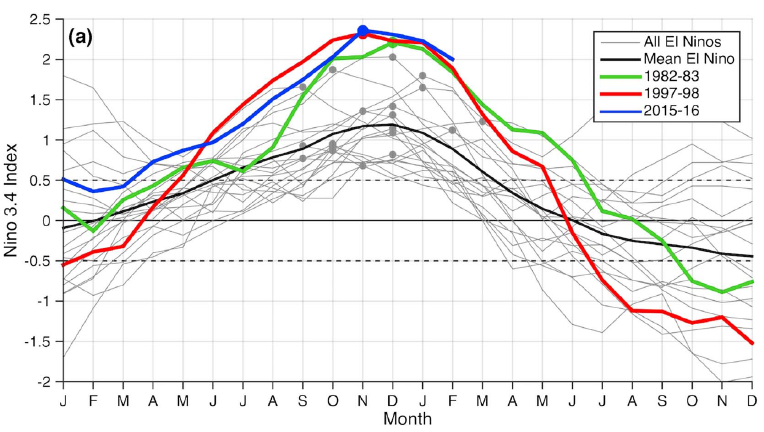California Current System Could Experience Weak El Niño-Related Impacts, Study Says
 A CPO-funded study published in Geophysical Research Letters concluded that although tropical Pacific sea surface temperatures hit a record high during the 2015-2016 El Niño, impacts to marine ecosystems and primary production are likely to be weak in the California Current System. These impacts are expected to be weak because Kelvin waves and weakened upwelling-favorable winds did not accompany the anomalously warm temperatures in 2015-2016.
A CPO-funded study published in Geophysical Research Letters concluded that although tropical Pacific sea surface temperatures hit a record high during the 2015-2016 El Niño, impacts to marine ecosystems and primary production are likely to be weak in the California Current System. These impacts are expected to be weak because Kelvin waves and weakened upwelling-favorable winds did not accompany the anomalously warm temperatures in 2015-2016.
The study’s findings highlight El Niño’s potential to influence different regions in a number of ways. While the 2015-2016 El Niño is not expected to trigger widespread changes to the north Pacific’s ecosystems, El Niño events of similar magnitudes (1982-1983 and 1997-1998) resulted in significant changes to ecosystems in the North Pacific. Ocean physics, chemistry, and biology can be influenced due to El Niño’s effects on ocean wave propagation, as well as tropical convection and advection.
Analysis for equatorial Pacific temperature anomalies used the Niño 3.4 Index, in situ measurements and satellite observations of surface chlorophyll, and wind data. Researchers also used data from underwater gliders and ocean reanalysis.

Abstract:
The 2015–2016 El Niño is by some measures one of the strongest on record, comparable to the 1982–1983 and 1997–1998 events that triggered widespread ecosystem change in the northeast Pacific. Here we describe impacts of the 2015–2016 El Niño on the California Current System (CCS) and place them in historical context using a regional ocean model and underwater glider observations. Impacts on the physical state of the CCS are weaker than expected based on tropical sea surface temperature anomalies; temperature and density fields reflect persistence of multiyear anomalies more than El Niño. While we anticipate El Niño-related impacts on spring/summer 2016 productivity to be similarly weak, their combination with preexisting anomalous conditions likely means continued low phytoplankton biomass. This study highlights the need for regional metrics of El Niño’s effects and demonstrates the potential to assess these effects before the upwelling season, when altered ecosystem functioning is most apparent.
Read the full report of the study: http://onlinelibrary.wiley.com/doi/10.1002/2016GL069716/abstract